 History of Seiko and the Clock Tower
History of Seiko and the Clock Tower
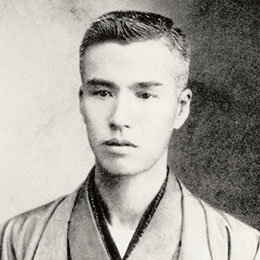
Founding of the Company
Kintaro Hattori establishes the K. Hattori Clock Store (now Seiko Holdings Corporation).
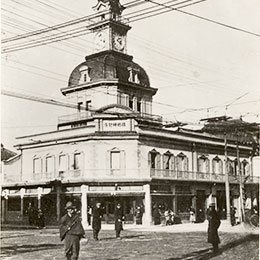
Completion of the first clock tower
In September, Kintaro Hattori purchases the Choya Shinbun newspaper office building on the corner of Ginza 4-chome intersection, and commissions Tamekichi Ito, who had studied architecture in the U.S., to expand and renovate the building. Construction is completed in December of the same year.
In January, Kintaro moves his store to the new location in Ginza 4-chome and begins operations.
With the economic boom in the Taisho era (1915 - 1926), the number of multi-story stone buildings begins to increase in the Marunouchi area, and plans are made to rebuild the company building. The company moves to a temporary sales office in Ginza 2-chome, Kyobashi-ku.
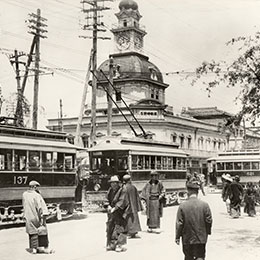
First clock tower dismantled
The mechanical parts of the clock tower are later transferred to the newly built Osaka branch of K. Hattori & Co., Ltd., where they are rebuilt as a new clock tower. This edifice looks out over Japan’s second-largest city through many difficult times until it is finally destroyed in the war in 1945.
In September, just as the foundation for the new building is being laid, the Great Kanto Earthquake strikes. The earthquake completely scraps the construction plan.
Construction begins on the second clock tower, based on a new architectural plan by Jin Watanabe Construction Firm and built by Shimizu Gumi, Ltd. (now Shimizu Corporation).
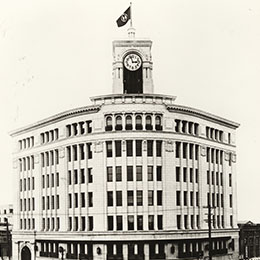
Completion of the second clock tower
Now the head office of K. Hattori & Co., Ltd., the inauguration ceremony of the "second clock tower" is held on June 10, Japan’s Time Memorial Day. Two days later, on June 12, K. Hattori & Co., Ltd. opens its newly renovated store.
The imported Italian marble inside walls, decorative arabesque fittings, and wide store windows were revolutionary at the time.
On January 27, a wave of B-29 bombers leveled Ginza and the surrounding area. Photos of the aftermath show block after block of rubble where buildings once stood. And yet, miraculously, the K. Hattori & Co., Ltd. head office at the Ginza 4-chome intersection survived almost unscathed. The building was still standing solidly; only three panels on the clock tower dial were damaged by the explosions.
In October of that year, GHQ confiscated the head office building and turned it into a military Post Exchange.
In April, Wako Co., Ltd. is established in Ginza, the successor to the retail division of K. Hattori & Co., Ltd. The company begins operations in a temporary store.
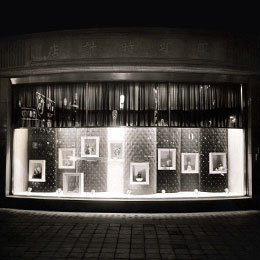
Wako display window
In April, GHQ relinquish use of the building. In December of that year, the K. Hattori & Co., Ltd. head office and Wako move into the still-intact building at the Ginza 4-chome intersection, and Wako officially opens a retail store there.
The display window at this time was the result of a competition between up-and-coming designers Hiromu Hara, Yusaku Kamekura, and Kenji Ito, and attracted a great deal of attention.
Chimes in the clock tower
Beginning on June 10 (Time Memorial Day), the clock, which had previously only rung to mark the hours, begins to sound Westminster-style chimes on the quarter hour.
The clock, which was powered by a weight-winding system, is converted to a Seiko quartz oscillation movement. In 1974, that first quartz movement is replaced with an even higher-precision quartz movement to ensure more accurate timekeeping.
New GPS system is installed in the clock tower.
The modern clock tower
The building undergoes a major renovation project that lasts almost a year.
While maintaining its historical image, the building is made safer and more comfortable by incorporating modern technology, strengthening its earthquake resistance, and making it barrier-free for those with disabilities.
As a result, the building is recognized by the Tokyo Fire Department for its excellence in fire safety, and in December of the same year, it is awarded a Certificate of Outstanding Fire Prevention (Superior Class).
Recognized as a building representing Japan’s “Heritage of Industrial Modernization” by the Ministry of Economy, Trade and Industry (METI)
The Wako Main Building is recognized by METI as one of the 33 Heritage Constellations of Industrial Modernization in two categories:
Items that tell the history of the city's entertainment and consumer culture, which grew together with the development of modern society
Items that embody the history of urban development that laid the foundation of today's Tokyo
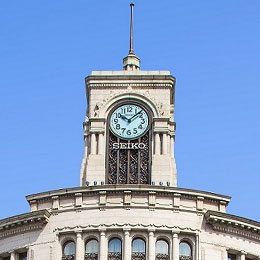
The Seiko logo is once again prominent on the clock tower.
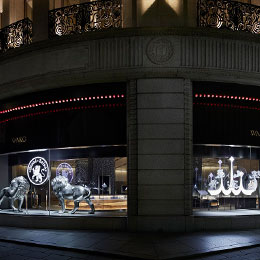
Part of the building is renovated
the display windows are made see-through to reveal the attractive retail space inside.
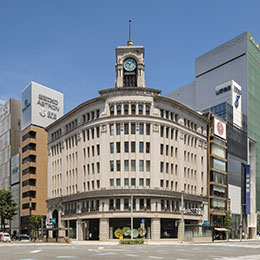
SEIKO HOUSE
opens
Changed the name of WAKO Main Building to SEIKO HOUSE.
Building Specifications
-
Height from ground to clock tower:
39.39 m (Height to rooftop: 30.30 m, height of clock tower: 9.09 m)
-
Height of lightning rod on top of the clock tower:
8m
-
Size of the Clock Dial:
2.4 m in diameter
-
Length of Clock Hands:
Minute hand: 1.17 m, hour hand: 0.75 m
-
Exterior finish:
1F and 2F: Mannari-ishi stone from Okayama Prefecture with a polished finish,
3F and above: Mikage-ishi granite from the Korean peninsula with tapped stone finish
- Top
- History



















